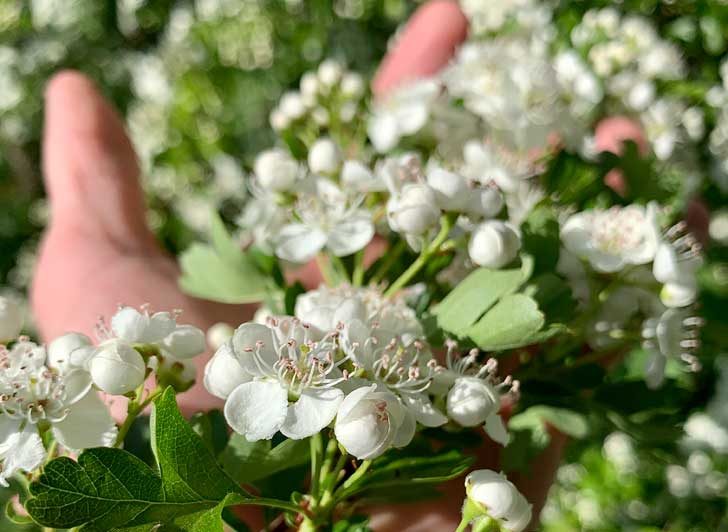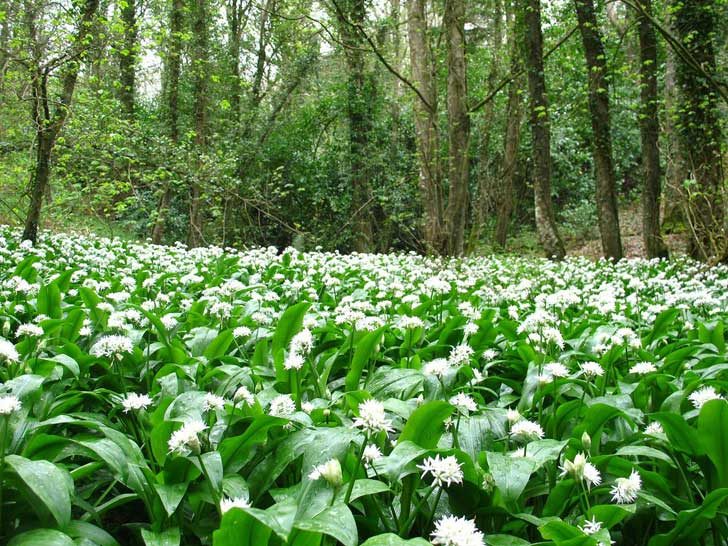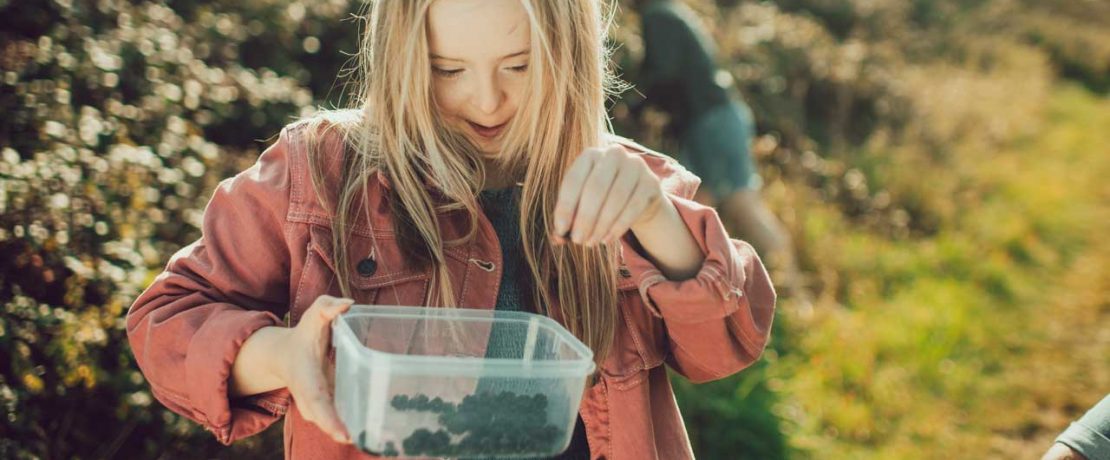Hedgerows through the seasons
We could easily take the hedges that trail across our countryside for granted. But these innocuous-looking, familiar features of the landscape are secret superheroes. Here’s how to recognise them and identify what tasty treats they might offer…
Hedgerows have often been described as the ‘stitching in the patchwork quilt of the English countryside. They’re certainly one of the most recognisable features of our landscapes.
Generally, they’re originally planted to mark boundaries of fields and provide shelter for livestock. So far, so functional. But there’s much more to them than that.
Hedgerows are a crucial factor in the existence of many plants and animals. In fact, many declining species rely on them to survive. The lines of hedges crisscrossing our countryside act as wildlife corridors, linking habitats together and providing safe movement for many scurrying, flying and scuttling animals such as endangered dormice and rare brown hairstreak butterflies.
Ancient superheroes
These innocuous-looking champions have climate-protecting powers, too. They actually suck carbon from the atmosphere and lock it up safely it in their roots and branches, making them a vital ally in the fight against climate change.
Some of our hedges are ancient, even medieval in origin. Imagine what they could tell us if they could talk? The oldest known surviving hedgerow in England is the so-called Judith’s Hedge, Cambridgeshire, at over 900 years old!
It’s easy to forget that hedgerows are essentially trees that have been managed, using a very old and increasingly rare form of craftsmanship, to form a lower hedge instead of growing upright into a tree as we think of them. And there are many species of tree that are particularly suited to hedging – many which can prove bountiful for the casual forager.
So: ready to get out and get exploring? Here’s our guide to hedgerows through the seasons.

Hawthorn
The pale green leaves of the hawthorn are often the first to emerge in spring, with pretty clouds of white flowers following in May. The welcome sight of bees busily collecting nectar from the puffs of these flowers is a sure sign that spring is well on its way towards summer.
Leaves
Hawthorn leaves are oval-shaped with deep lobes that cut at least halfway to the middle of the leaf. Look out for leaves with serrated (jagged) edges.
Flowers
The flowers are highly scented and emerge in May. They’re white or sometimes pink, with lots of stamens in the middle, and grow in clusters that have a flat top.
Berries
Called haws, the berries are deep red and stand out in the late-summer hedgerow. Traditionally hawthorn berries are used to make jellies, wines and ketchup.
Blackthorn
Blackthorn is a spiny, shrubby tree with narrow leaves and the dark, spiny twigs that give it its name. They’re often the first to flower in the spring, with white flowers that appear in tight clusters – often coming out as early as February. A welcome sight as winter draws to a close!

Leaves
These are oval and small, with very a fine ‘tooth’ along the edge.
Flowers
Blackthorn flowers from March to June, with creamy-white flowers with five petals. They’re easily confused with hawthorn, but here’s a handy rule of thumb to avoid this ‘thorny’ confusion: blackthorn blossoms before its leaves start to show, whereas hawthorn flowers after its leaves have emerged.

Fruits
Heard of sloe gin? You might not have realised, but sloes are in fact the berries of the blackthorn! These inky blue-black fruits are a common sight across our countryside in autumn. Sloes are used to make wine, preserves and sloe gin.
Pro tip: If they’re ripe, dark purple and easy to squash between your fingers, they’re ready for picking. Traditionally, they were said to best for making sloe gin after the first frost, but you can replicate that effect nowadays by popping them into the freezer in a bag.
Wild garlic

Not quite a hedgerow plant, but we had to give this forager’s friend an honourable mention.
This pungent plant carpets the floor of ancient woodland and is an important early source of food for bees and other insects. You might also know it as ramsons, wood garlic or bear garlic (because it was thought to be a favourite food for brown bears!). The plants start to appear as early as February in the south of England and can be seen as late as June – so keep your foraging eyes peeled well into summer.
Leaves
These are long, broad and deep green, although narrower when the plant is young. You might find you can smell them before you see them!
Flowers
Globe-shaped at the end of long stalks. These don’t appear until later in the spring.
Uses
Wild garlic can be used in pestos, soups, salads, stews and anything else where you’d normally use garlic. But be careful when foraging – it looks very similar to the poisonous Lily of the Valley.
Hazel
Hazel trees are often found in hedgerows and woodlands as an important component of the ‘understory’ (the lower levels), as they’re a low, shrub-like tree.
Hazel trees coppice well and so have long been valued for providing fast-growing wood for flexible sticks and poles. Some coppiced hazel trees can live for many hundreds of years, greatly exceeding their normal lifespan, through the constant regeneration brought about by the coppicing process.
Leaves
Hazel leaves are rounded, with a heart-shaped base and pointed tip. The edges of the leaves are double-toothed, and the upper surface is hairy to the touch.

Flowers
The male flowers, the brilliantly-named ‘catkins’, first appear in autumn. These hang down and turn yellow before opening in the spring, revealing tiny yellow flowers. The female flowers appear as tiny red protrusions, from January onwards (baffled by the idea of male and female flowers? Learn more).
Fruits
Fresh hazel nuts, and the cultivated ‘cob’ nuts, have a gentler taste than the ones we get in our breakfast cereal and are well worth seeking out. The nuts are green and have a papery-feeling outer. Dormice are particularly reliant on these nuts so be sure to leave some behind!
Elder
Elder is a brilliant foragers’ shrub: it’s very common, so shouldn’t be too hard to find, and has no fewer than three edible crops!
A common hedgerow tree, they’re most identifiable in spring and late summer because of their distinctive flowers and berries. Near rabbit warrens or badger setts? Then keep a weather eye out, as these animals distribute elder seeds in their droppings.
Leaves
Elders’ leaves are ‘pinnate’, meaning their shape is like a feather. And give them a little sniff: when touched or crushed, they don’t smell at all good!

Flowers
Elderflowers grow in large clusters (called ‘umbels’ – imagine an umbrella) with a flat top, and each small flower has five petals. They have a strong scent and a creamy white colour, and are prized in spring for making cordial.
Berries
From September, it’s the dark purple berries that are weighing down elder branches. They’re not recommended for eating raw, but they make for good flavour and colour in fruit vinegar and are particularly prized for wine-making. You can even bake them in a pie with blackberries!

Brambles
While not a tree, this voracious plant deserves an honorary mention. Familiar to so many of us, they’re often a key component of hedgerows, forcing out a niche for itself among the twisted branches of the hedge. Really, any rough ground is likely to throw up some blackberries as they’re resilient and persistent – as any gardener can testify!
Leaves
There are hundreds of different species of bramble with highly variable leaves. If you’re trying to spot a bramble, your best bet is to keep a keen eye out for the fruit…
Flowers
These are small, with 5 petals (sometimes more) and pink to white in colour.

Fruits
Brambles are thorny and not worth troubling for most of the year, but with their instantly-recognizable blackberry fruits they become an autumn delight.
The darker and juicier the berries, the better – and the few that make it home will be good for pies or jams. Remember to only pick berries from above waist-height, and leave plenty for wildlife that use them to ready for winter.
Crab apple
Crab apples, with their twisted, gnarly branches, are found across the countryside, standing alone or as hedgerow trees.
They readily mix with other species of apple so it’s often hard to tell which one you’re looking at. Feeling brave? A good guide is the sourness of the fruits – the sourer they are, the more likely they are to be a crab apple. Crunch away…

Leaves
Crab apple leaves are generally oval, smooth on both sides and with toothed edges.
Flowers
The flowers are small (4cm) and usually white, but sometimes pinkish. If the tree has blended with another kind of apple tree, it’ll have pinker flowers.
Fruits
The fruits might look like a bit the apples you’re used to eating, but are often small, yellowish-green and tough even when they’re ripe. Compared to cultivated apples they’re very sour and not good for eating raw – but they do make great jelly as they’re packed with pectin, the natural agent that makes jams set!
Wild cherry
These beautiful trees are widespread across England, both wild and planted. If your local urban street puts on wonderful spring blossom display, that might be because you’re lucky enough to live on one of the many English roads lined with cherry trees.
Leaves
Their leaves are long and oval, with irregular teeth pointing forwards along the sides. The leaves often have a pointed tip and have a downy, veined underside.

Flowers
Cherry flowers are white and grow in long-stalked clusters of 2-6, opening just before the leaves appear.
Fruits
Cherries ripen in early summer to a dark purple or deep red. If you find cherries that have sweetened they can be delicious, but they’re more often rather bitter. If you’re picking some for eating, make sure you get there before the birds do; they’ve been known to strip trees in less than a day!

Damsons
Damsons are thought to be a mix of a blackthorn and cherry plum and can be a delicious autumn fruit to use in similar ways to sloes or plums. These are found across the countryside, either planted or growing wild.
Leaves
The leaves have jagged edges, and are about 8cm long with a shiny upper surface.
Flowers
Like blackthorn, cherry and other plum varieties, these flowers are mostly white, with five petals and appearing in clusters.
Fruits
Damson fruits are roundish and can be dark blue to purple or even yellowish. They taste a bit like sour plum and are best made into jams, jellies and other puddings. You could even try your hand at damson gin, preparing just as you would for sloe gin.
Happy foraging! We’d love to see your seasonal hedgerow creations – share them with us on Facebook, Twitter and Instagram.









